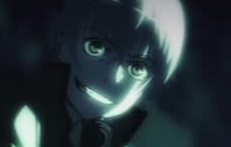A Harsh Move back to Form: Gundam Iron Blooded Orphans

It’s been a rough couple of years for the Gundam franchise, with two of the more recent series having been unappealing to myself and based on others’ opinions. There was the basic “Gundam AGE,” which in its attempt to become more approachable and bring in a new generation of Gundam fans became watered down and simplistic, though apparently the main character did improve towards the end. The 3 episodes I did watch displayed dialogue and a plotline more palatable to a younger crowd and quite basic, though artwork was bright and vibrant with quality drawings. Then there was the bizarre “Gundam G in Reconquista,” which marked a return of Yoshiyuki Tomino to the franchise. At only 24 episodes for the entire arc, this was half the number of episodes as a typical Gundam franchise. Having watched the first episode only, the most striking aspect was the artwork. Shapes are very ovoid and elliptical in nature, with very rounded edges on everything from characters to machinery, with the whole thing looking like a Salvador Dali painting. There was also a very large quantity of blue and turquoise used in the artwork, and the plot and dialogue after one episode was not clear at all. I set this one aside as well, and a good friend of mine who was very familiar with Gundam did say that the convoluted plot at the end of the series resulted in a heap of criticism launched towards the unflappable Tomino. It was with this friend and in this environment that we began watching “Gundam Iron Blooded Orphans.” Is this the Gundam that brings the franchise back into correct form?

Unlike the two aforementioned Gundam series, “Iron Blooded Orphans” is the appropriate length, at 2 seasons of 25 episodes each. The series wastes no time in portraying itself as much more raw and visceral than a typical Gundam series, as the betrayal of the main characters early on leads them to brutally execute the traitors. This doctrine forms the basis of how the protagonists operate: through informal strands of loyalty, of which betrayal is punishable by consequences up to and including death. This ragtag group of outcasts known as “Tekkadan” operate as a mercenary group fighting for Martian independence whilst united under the skillful and charismatic Orga Itsuka. The ragtag nature is quite evident upon the introduction of several secondary Tekkadan characters, such as Biscuit, Eugene, and Akihiro. It’s a bizarre collection of personalities, philosophies, and tactics, but is clearly a top-down operation, where loyalty and deference to Orga is pantamount. Now, this is somewhat balanced out by the respect that Orga gives back to his subordinates, and when one looks at the tactics the underdog Tekkadan uses against their adversaries, (most prominently the aristocratic Gjallarhorn organization), one can’t help but feel more than a tinge of admiration and awe. However, this is a Gundam series, and the sole Gundam here is an ancient, but powerful, relic from a war fought 300 years previously known as the “Barabatos,” and piloted by the stoic, skillful, and utterly apathetic Mikazuki Augus. Admirable though he is against his opponents and respected by all in his team, this character’s motivation is “whatever Orga wishes.” He has no personality, no flair, no personal motivation or feelings, and instead he comes off as a walking corpse. Instead, one must look towards the ragtag group of side characters for entertainment, as the series manages to mold these mismatched characters’ dialogue, philosophies, and priorities into a plotline that feels genuine and satisfying.

The series touches on quite a lot of identifiable themes in the characters, including loyalty, trust, justice, and honor. In the overall political environment of the series, there are themes of duty, loyalty, independence, peace, conflict, and betrayal. Just listen to the fervor that the opening and ending themes portray, along with the extensive use of stringed instruments in the score that evoke strong feelings of enigma and independence. There are parallels in this series to today’s environment, where one sees how the media is used as a weapon by Gjallarhorn against their adversaries, using fabricated images and falsified stories to justify their use of force. One also sees the internal politics of a corrupt governing body, along with others caught in the middle trying to decide where one’s loyalties lie along with how, for whom, for what, and why one is fighting. This theme permeates itself throughout the series, and is deep and heartfelt for the members of Tekkadan.
In contrast, members of Gjallarhorn fight mainly for honor and vengeance, trying to save face for lost comrades despite their oftentimes inferior tactical skills. It is oftentimes painful to watch, as several characters in Gjallarhorn have let power go way to their heads, believing that Tekkadan would surrender after hearing a grandiose speech about their royal pedigree despite being completely inept at piloting a mobile suit (the characters Carta Issue and Iok Kujan are the worst offenders). These amusing lopsided battles balance out the cringeworthy side characters of Gjallarhorn, and as a whole, seeing how the tactics play out in battles is a strong point of the series. Just seeing the anguish and tension in Orga’s face, mixed in with the fear, concern, and determination of his underlings, combined with fast, deliberate action, excellent animation and extensive choreography expertly draw in the viewer and keep them on edge. One sees the sparks, the smoke from the explosions, the laser beams, with the bright, vibrant, but not overbearing colors. In between battles, one sees the more humanistic sides of Tekkadan and their Teiwaz allies, as the series also touches on the very sensitive subject of child soldiers (known as Human Debris here) and others who literally have nothing to lose and live just to find value in the world. Scenes such as Mikazuki learning how to write his own name, Orga constantly worrying about Gjallarhorn’s financial situation, and Akihiro’s constant sense of inadequacy portray a certain emptiness in these characters and drive home the reality of their situation. Contrast that with the lead female character Kudelia Aina Bernstein, who manages to combine the heart of “Gundam 00’s” Marina Ismail and the will of “Gundam Wing’s” Relena Peacecraft to utilize her extensive diplomatic skills to fight for a better world. Her confidence and fearlessness is a very welcome addition to the series, and though she doesn’t pilot a mobile suit and relies on Gjallarhorn to escort her safely to Earth for political duties, her independence and lack of acting as a damsel in distress make her to be one of the best female characters in all of Gundam.

Both Kudelia’s role and the prominence of Gjallarhorn increase significantly in the second season, and the addition of several other factions and shifting state of alliances complicates the plotline immensely. Now, this complicates matters quite significantly, and keeping track of characters in the second season becomes more difficult, not made easy with the sudden addition of side characters from both sides who seemingly just get plopped in with little explanation. Elements of the past are inserted in an attempt to give the plot some more depth but these insertions are sometimes haphazard and oftentimes only briefly touched on before being tossed aside. Thankfully, the plotline continues at a steady rate and there is no rush to the finish, though the series does begin to wander and lose some of its structure in the last third of the second season, leading one to try and futilely grasp where the series will go next. The ending is conclusive, though quite melancholy.
So where does that leave “Gundam Iron Blooded Orphans?” Well, it certainly is a return to form, despite one of the weakest main characters ever to grace a Gundam series and a weaker storyline during the second season. It is an interesting look into a type of organization that has many parallels with terrorism, and their underdog nature with a superior weapon is an interesting position to be in. The series has strong themes regarding determination, independence, and loyalty, though the violence can make some viewers uncomfortable. The storyline is one that peaks around the end of the first season and moving into the second, though the falloff is not too severe by the end of the second season. Even though the plot feels ragtag and gets pulled this way and that, it still doesn’t feel random and instead there is purpose and reason as to why it goes a particular way. So all in all, a solid series. Not the best, but a solid B. Worthy of one’s time, and do check out the second season on Toonami (the first season aired in 2016) this coming October.





